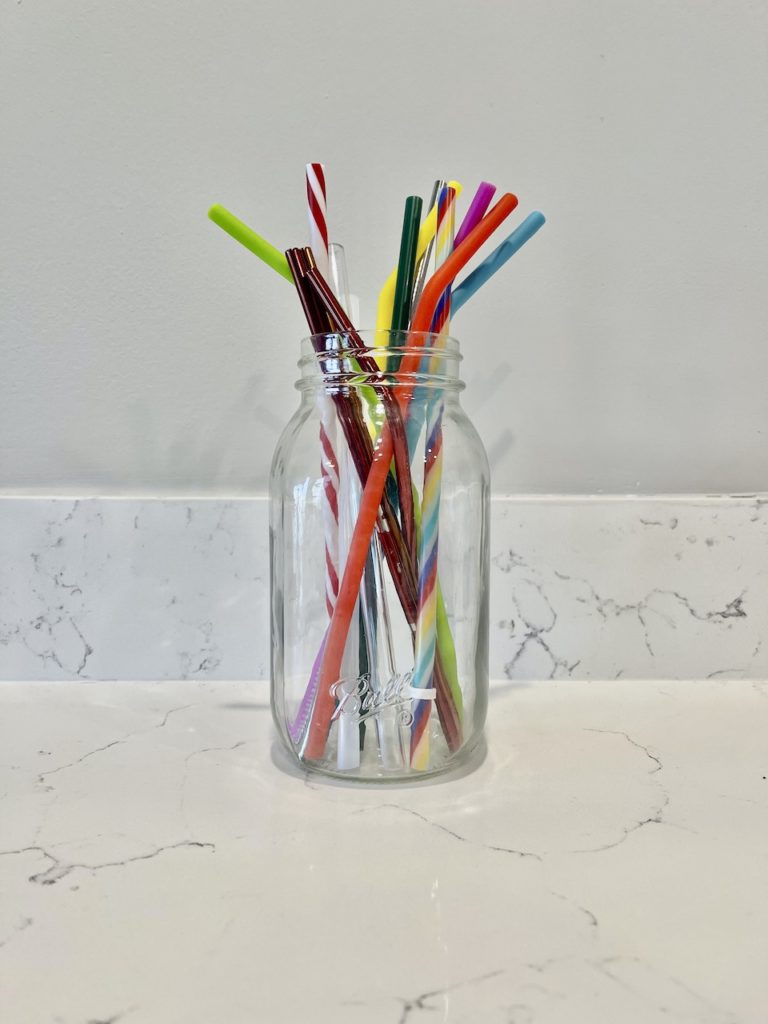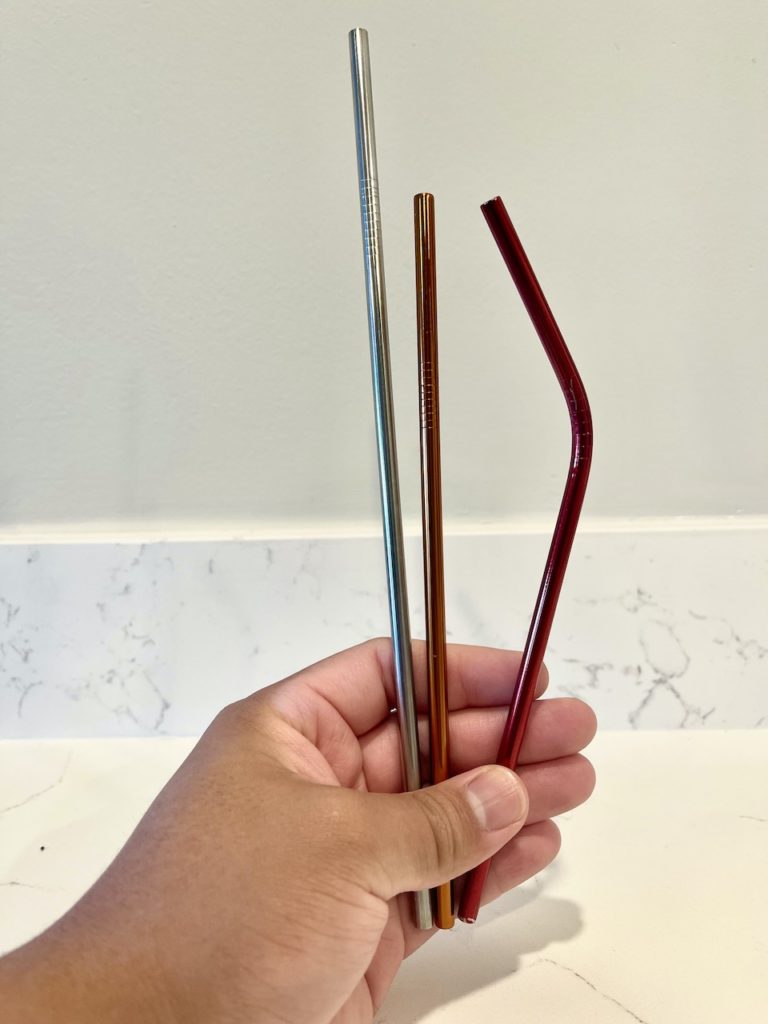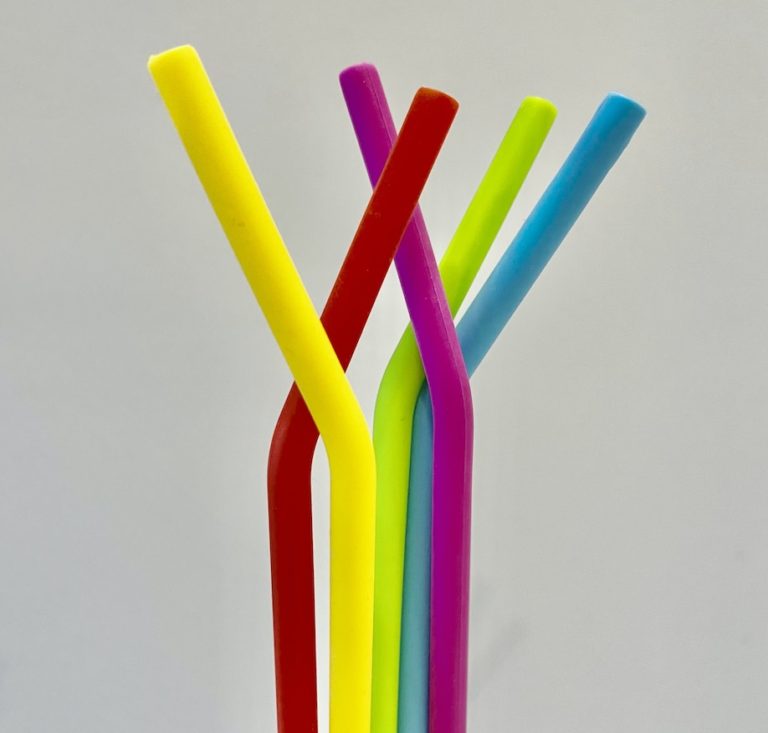Metal straws! Whoop whoop! Chances are you’ve seen someone using them, heard their familiar clank, seen them in stores, or maybe even own a couple. We’ve all been told that they are the solution to single-use plastic straws, an end all be all to eliminating those pesky unrecyclable plastic tubes. But are they?
Well, maybe. You see, it all depends on which kind of straw you choose to buy, how often you use it, and if it’s actually replacing something. There are more options to choose from than just metal, like plastic and silicone. So let’s look at all the different kinds of straws and compare them to the single-use plastic straw to see how much reusable straws actually help the environment.
What are metal straws supposed to do?
Straws were created to help us reach our beverages and continue to do that very well. Only, after decades of consumption, the plastic hasn’t gone anywhere. It went from our cups to the trash, and then into the earth or the ocean, only to be endlessly tossed in the current.
Plastic will undoubtedly end up in our sea friends, sea food, and then eventually you and me. In fact, it already does and those are called microplastics. You can expect several microplastics to be in your average can of tuna from the grocery store.
You’ve also likely seen those viral videos of turtles with straws stuck in their nose, or other wildlife grappling with plastic pollution. Imagery like that helped to sensationalize the reusable straw movement and really fuel the bans you’re familiar with as well as the booming market for plastic straw alternatives.
A Little Straw History
Reusable straws seem to have really taken off in the last 5 years. Getting coverage on major news outlets, plastered all over social media, and even encouraging plastic straw bans across the country. National Geographic says we’ve been using straws for thousands of years, but the plastic variety as we know them only began to be mass produced pretty recently.
Plastic is often cheaper and easier to create and distribute for manufacturers and retailers. It should come as no surprise that plastic straws were more popular than their predecessor, the paper straw. Only, now we have to deal with the consequences of a material that won’t completely breakdown in our environment.
So what options are there for plastic straw alternatives?

Probably the most common option is the metal straw. But, there are also reusable glass straws, plastic straws, silicone straws, bamboo straws, and more. These kinds of reusable straws tend to be more for long-term use, ranging from one year to years and years. These will be the focus of this post but, there are also other single use alternatives some establishments like to boast, like sugar cane straws and the oh-so hated paper straw.
Do they actually help?
Finally, the meat (or tofu) of what we’re looking at today. The answer can be yes. But, it can also be no. It really depends. So to understand what makes your reusable straw more good than bad (hopefully), let’s take a look at how the footprint of disposable plastic straws compares to the footprints of long-term alternatives. In other words, how many times do you need to use that metal straw in order for it to actually make a difference?
The Footprint of Different Straws
Rather than showing you too many fancy numbers that come with looking at the footprint of a product, I’m simply going to be talking about how many times you need to use a straw for it to do more good than harm (in theory).
But sadly, we do have to look at one set of sciencey numbers to understand how I’m reaching these conclusions about how many times you need to use that metal straw. If you’re not into numbers then you can skip this next section and pick up at “Less Numbers.”
The Numbers
The plastic straw is our baseline, and the carbon footprint of a single use plastic straw is about 1.5 (gCO2/straw) according to Appropedia. For a stainless steel straw, that number shoots up to 217 (gCO2/straw).
What this means is, if you divide 217 by 1.5, you’ll get roughly 150 (I’m rounding here). That is essentially how much more carbon dioxide a metal straw causes compared to a single-use plastic straw. In other words, 150 single-use plastic straws and 1 metal straw have roughly the same carbon footprint. So you would need to use a metal straw more than 150 times in order for you to actually be saving on carbon dioxide emissions.
That same math is done for all the other reusable alternatives and in this post, I’m going to be using carbon footprint. I’ll explain why that matters later. For now, let’s move on to the rest of the comparisons and put these numbers into the bigger picture.
Less Numbers
You made it! Now for less numbers and math. So, if you opt in for a metal straw, you’re going to need to get at least 150 uses out of it just to break even with a plastic straw.
Appropedia has the best breakdown I was able to find so I’m using their numbers here. According to them, you would need to use a glass straw 45 times to break even with a disposable plastic straw, and a bamboo straw 32 times.
Truthfully, if you actually want to be making a difference, you’d need to use it far more. Those numbers are just your break even point. That means if you just use a metal straw 150 times and then toss it, maybe you saved in physical waste but you still produced the same amount of carbon compared to using and tossing 150 plastic straws.
Figuring Out What's Right for You

Now, how do you determine what’s the best choice for you? The main thing you’ll want to consider is whether or not you even use straws.
For the Everyday Straw Users
I’m going to reveal something embarrassing about myself here. There was once a time when I would go through boxes and boxes of single-use plastic straws. They were regularly on the family grocery list. Why?
I used straws to avoid colored beverages. I would drink things like tea and coffee through straws primarily to avoid staining my teeth. I know, how vain. But, I still do it. Only now, I use a variety of reusable straws.
For me, reusable straws made sense because I was actively using single-use plastic straws and replacing them meant I would undoubtedly meet 150 uses and beyond. Chances are, I meet that within a year, and metal straws are said to last for 5+ years.
If that’s you, then metal, glass, silicone, or bamboo might make sense for you.
For Light Straw Users
If you never use straws at home, never reach for them at the coffee shop, and only occasionally use them when dining out, then you’d be much better off just declinding the straw altogether and drinking from the cup.
For Moderate Straw Users
If you’re maybe somewhere in the middle, then a middle tier alternative would probably fit your lifestyle best. Think bamboo or glass. You could use those once a week for a year and still have a positive impact on the environment.
Flaws with My Reasoning
Earlier, in the numbers section, I said I was referring to the straw’s carbon footprint in order to get my final numbers. I said that’d be important later, well here we are.
Thinking about plastic straw alternatives goes beyond just the carbon footprint. Look at metal straws for example. You likely will find stainless steel straws in stores, but that metal has to come from somewhere. It has to be mined, processed, shipped, packaged, distributed, unpackaged, and so much more in order to make it into your hands.
The same is especially true for plastic reusables because single-use or not, plastic still comes from oil.
Supply chains are long and intense, and there is potential for waste at every step along the way. So in just looking at the carbon footprint of a product, we’re kind of looking at just a couple pieces of the 1000-piece puzzle.
Don’t get me wrong, it’s a good metric to use but it’s important for us to consider the bigger picture too.
Final Answer:

Do metal straws help the environment? Do metal straws save the planet?
You should have said, it depends in your head. If you didn’t, I’m sorry I’ve failed you. But it’s true, it just depends.
All in all, it’s unlikely to “save the planet,” but it will help the environment if you actually use your straws accordingly.
Phys.org says that plastic straws only make up about 4% of plastic pollution (by piece, not by weight). To bring the puzzle analogy forward, that’s like 4 puzzle pieces to a 100-piece puzzle.
If you swap out plastic straws for reusable ones, in no way is your puzzle done. You’ve got 96 more pieces to add. But it’s a start. And that’s what you should take away from this. Choose the plastic straw alternative that best fits your current straw usage, and make the swap.
You ABSOLUTELY should still make the swap, but it’s not going to save the planet on its own or make a huge dent in our pollution crisis. There’s still more for you to do and you can do that piece by piece, step by step. So add your piece (because the puzzle won’t be complete without those 4 pieces), and then add another, and we’ll keep working towards a more sustainable, less wasteful future together.
Thanks for joining me today! If you liked this content and want to see more, please subscribe to my newsletter. You can do that here!
In case you didn’t catch my post about plastic in sustainable swaps, you can check it out here.
Sustainably is supported by readers like you. When you buy through links on this site, we may earn an affiliate commission at no additional cost to you. You can read more about affiliate links on our “Affiliate Marketing…” page.
Pingback: How To Use Cardboard Boxes To Lower Christmas Waste - Sustainably
Pingback: 16 Sustainable and Eco-Friendly Gift Ideas for 2021 Holidays - Sustainably